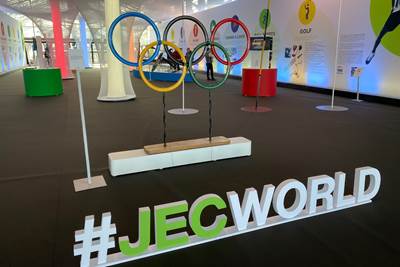Achieving composites innovation through collaboration
Stephen Heinz, vice president of R&I for Syensqo delivered an inspirational keynote at SAMPE 2024, highlighting the significant role of composite materials in emerging technologies and encouraging broader collaboration within the manufacturing community.

Syensqo VP of R&I Stephen Heinz delivers keynote address at SAMPE 2024. Source | CW
In late May, CW attended the SAMPE conference and trade show in Long Beach, California, an event that always provides valuable insights into industry trends. This year’s function placed an emphasis on forwarding applications like vehicle electrification, hydrogen energy and sustainable solutions through broader industry collaboration, with a more open-minded approach to material solutions.
The keynote address was delivered by Stephen Heinz, vice president of R&I for Syensqo’s Composite Materials Division (formerly part of Solvay Group). Heinz delivered an inspirational talk, highlighting the significant role of composite materials in today’s world. He discussed various aspects of advanced materials, focusing on composites and their applications across different industries to enhance sustainability and performance. Heinz emphasized the use of composite materials, such as carbon fiber, in creating lightweight structures for smart devices, automotive, aerospace and marine applications. He underscored the benefits of composites in reducing weight, enhancing strength, and improving resistance to corrosion and fatigue.
Heinz also warned against falling into the common traps of being overprotective of R&D and having any one singular focus in developing applications. “Avoid marrying a solution,” he advised. “No one approach is the solution to every problem.”
“Our industry’s growth is a result of a demand for a more connected world.”
Heinz outlined Syensqo’s priorities, which include advancing the functionality and lightweighting of evolving smart devices, focusing on the green hydrogen market and exploring composite opportunities in electric vehicles (EVs) and urban air mobility (UAM). Regarding the future of composites in aerospace, Heinz avoided speculation about when a new commercial aircraft program might emerge. Instead, he confidently stated, “The next commercial aircraft will employ a lot of composite materials.”
The unifying theme across all these discussion points is the contribution to more connected and sustainable technologies. “Our industry’s growth is a result of a demand for a more connected world,” Heinz said. He emphasized that the need for connectivity demands materials with increased functionality, such as heat resistance, damage resilience and structural transparency for communication systems.
Not to be forgotten are challenges like incorporating sustainable solutions and life cycle considerations, including efficient production systems from part design and material selection to service life and recycling into every application. The industry’s commitment to reducing waste, minimizing the carbon footprint and developing sustainable materials has never been greater.
Outside of Syensqo’s keynote, the various technology solutions on display at SAMPE, the conference presentations and conversations at the event underscored the continuous need for innovation, collaboration and adaptation to new technologies and societal shifts in order to achieve these overarching goals. Heinz even encouraged broader community collaboration, including partnerships with startups and universities, and emphasized embracing data management solutions, artificial intelligence, automation and augmented reality to drive innovation.
This call to action resonated through the conference as a reminder of the industry’s mission. This past year saw the loss of two of its leaders: Scott Beckwith, SAMPE global technical director, and Camelo Lo Faro, president of Solvay’s Materials Segment. Their passing is a significant loss in terms of leadership and experience, but also acts as a poignant reminder of the impact of one’s life work. Both men dedicated their careers not only to the composites industry but also to the vision that the industry serves. Their contributions are examples of the true charge of the composites industry — exploring materials and solutions for the betterment of our world.
In alignment with these themes, the July issue of CW touches on innovation of all kinds. Check out the Past, Present and Future column by Collin Heller, vice president of Counterpoint Market Intelligence Ltd., offering insights into the future design of commercial aircraft (p. 10). Learn about a new family of TPS solutions designed to enable a range of applications including space launch systems, battery enclosures, exhaust systems and electronics (p. 5). Get the backstory on Aptera’s crowd-funded solar electric vehicle and the role composite materials play in its design (p. 38). And don’t forget to read about Aernova Aerospace’s RTM and ATL/AFP high-rate production sites that supply aerostructures for supplying Airbus and Airbus Helicopters, Boeing, Embraer, Dassault, General Dynamics and others (p. 24). We hope you enjoy the issue.
Related Content
Revisiting the OceanGate Titan disaster
A year has passed since the tragic loss of the Titan submersible that claimed the lives of five people. What lessons have been learned from the disaster?
Read MoreUp, not out: The next chapter of CompositesWorld
I have been editor-in-chief of CompositesWorld for 17 years, which translates into a lot of editorials. This will be my last as I become publisher of CW. We welcome Scott Francis back to the brand to take my place.
Read MoreYour must-have composites industry guide for 2025
Welcome to CW’s annual SourceBook, your guide to suppliers of machinery, materials, software and other services for the composites industry.
Read MoreHow has CW changed in the last year?
Upon his one-year anniversary as editor-in-chief of CW, Scott Francis looks back at some of the brand’s changes and hints at where it might be heading next.
Read MoreRead Next
Looking at composites through the lens of U.S. history
When you’re a tourist with a background in writing for manufacturing it’s impossible not to notice all of the ways in which composites have resulted in significant milestones in the U.S. — historically and in the present.
Read MoreA return to JEC World
CW editor-in-chief Scott Francis reflects on the ways in which the composites industry has changed and also stayed the same based on observations from this year’s JEC World.
Read MoreHow has CW changed in the last year?
Upon his one-year anniversary as editor-in-chief of CW, Scott Francis looks back at some of the brand’s changes and hints at where it might be heading next.
Read More






















